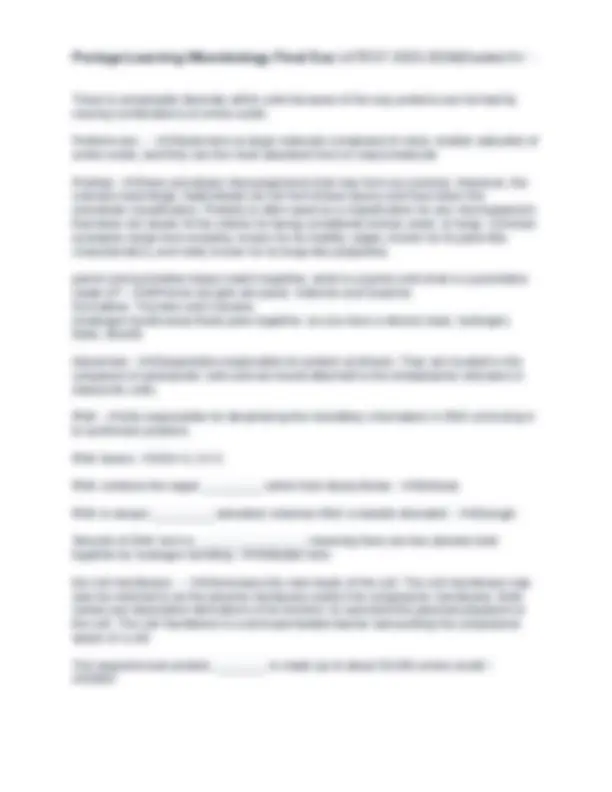











Study with the several resources on Docsity

Earn points by helping other students or get them with a premium plan


Prepare for your exams
Study with the several resources on Docsity

Earn points to download
Earn points by helping other students or get them with a premium plan
Community
Ask the community for help and clear up your study doubts
Discover the best universities in your country according to Docsity users
Free resources
Download our free guides on studying techniques, anxiety management strategies, and thesis advice from Docsity tutors
An in-depth exploration of microorganisms, their structures, and functions. It covers various types of microorganisms such as bacteria, fungi, and viruses, and discusses their roles in our lives, both beneficial and harmful. The document also delves into the structures of cells, including the cell membrane, nucleus, mitochondria, and organelles like the endoplasmic reticulum and golgi complex. It explains the roles of macromolecules such as proteins, nucleic acids, lipids, and polysaccharides in cells. The document also discusses the use of microscopes for observing microorganisms and their movements.
Typology: Exams
1 / 17

This page cannot be seen from the preview
Don't miss anything!










A researcher is looking to determine the source of contamination of a patient that presented with symptoms of food poisoning. To best determine between E. coli or Salmonella as the cause, what type of agar will be used to isolate the growth of each? - ANSDifferential media Bacteria that have a curved rod morphology are referred to as ______. - ANSVibrio Briefly explain how a Scanning Electron Microscope (SEM) forms an image of subcellular organelles, substrates, and viral particles. - ANSAn image is formed from the interactions of electrons as they reflect off (not through) the surface of the specimen. Samples are coated in either gold or palladium to enhance electron reflections. The reflection is seen in 3-D rendering. Describe the ONE main differences between lytic and temperate phages. - ANSLytic bacteriophages replicate within the host bacteria until it ruptures, whereas temperate (or lysogenic) phages primarily exist in a non-replicative state that does not kill the host cell. Describe TWO differences between DNA and RNA. - ANSAny of the following are acceptable answers: RNA contains the sugar ribose rather than deoxyribose. RNA is always single-stranded, whereas DNA is double-stranded. While RNA contains the bases adenine, guanine, and cytosine, it does not utilize the pyrimidine base thymine. Instead, RNA contains uracil (U), which still pairs with adenine (A). Each of the following statements about glycolysis is true, except:
E.coli Archaeons Yeast Amoeba - ANSE.coli - Prokaryote Archaeons - Prokaryote Yeast - Eukaryote Amoeba - Eukaryote Identify the following disease based upon the physical manifestation: - ANSAnthrax Left untreated, three percent of cases of Streptococcal pharyngitis will progress to which of the following? - ANSRheumatic fever Match each of the following diseases to the correct bacterial family. Scalded Skin Syndrome Bubonic PLague Opthalmia Neonatorium Legionnaires - ANSScalded Skin Syndrome - Staph Aureus Bubonic Plague - Yersina Pestis Opthalmia Neonatorium - Staphylococcus Legionnaires - Legionella Match each of the following organelles with the correct description. Nucleus Endoplasmic Reticulum Lysosomes Chloroplasts - ANSNucleus - Contains genomic content of the cell Endoplasmic Reticulum - Series of membrane-enclosed sacs and interconnected tubes Lysosomes - Contain hydrolytic enzymes capable of degrading unwanted cellular debris Chloroplasts - Site of photosynthesis Match each of the following terms with the correct description. Phototroph Lithotroph Autotroph Chemotroph - ANSPhototroph - Utilize photons of light to generate ATP from ADP Lithotroph - Remove electrons from inorganic molecules Autotroph - Obtain their source of carbon from inorganic molecules Chemotroph - Acquire energy from preformed chemicals found in the environment Match each type of agar plate to the corresponding general characteristics of each. LB Agar Trypticase Soy Agar MacConkey Agar
The Gram stain differentiates between bacteria based on the composition of their _____________. - ANSCell Wall There has been an outbreak of Staph Aureus within a local cleaning business. The employer Is trying to determine which of two companies has not been using sterile precautions when cleaning. To help determine who is responsible for unsanitary practices, a researcher streaks the isolated bacterial samples from each company onto MSA agar. After incubating the samples overnight at 37°C., briefly explain how he will interpret the result of his samples. - ANSA sample showing only colorless colonies growing on red agar would indicate the presence of non-pathogenic bacteria, while a sample showing a distinct yellow agar would indicate the presence of Staph aureus. True or False: Leprosy can move through the blood to other areas including the brain, spine, and kidneys. - ANSFalse: TB is primarily considered a respiratory infection, but once it fully colonizes the lungs, TB can move through the blood to other areas including the brain, spine, and kidneys. True or False: Proteins can function to catalyze biochemical processes and play a role in structure, but they cannot enable movement. - ANSFalse. Proteins can function to catalyze biochemical processes, play a role in structure, and they can enable movement. True or False: The metabolism of a lipid-derived carbon atom will yield more ATP than a molecule of glucose. - ANSTrue True or False. If the statement is false, change it to make it true. When grown on Blood Agar Plates (BAP), microbes capable of alpha hemolysis present as greenish-brown color colonies due to incomplete (partial) lysis of red blood cells. - ANSTrue; Alpha hemolysis presents as a greenish-brown color due to partial lysis of red blood cells. What coronavirus-associated infection gave rise to quarantining and travel restrictions in 2003? - ANSSARS What STD is caused by Gram-negative, diplococci, fastidious bacteria that may result in cardiac and neurological complications? - ANSGonorrhea Which of the following is/are true of Animalia? (Select all that apply)
Which of the following reactions is an example of a hydrolase? a. A + B → A-B b. A-B + H2O → A-OH + B-H c. A— + B →A + B— d. Ab + C → A + Cb - ANSb. A-B + H2O → A-OH + B-H Which region in a four phase dilutional streak contains the highest concentration of a microbial organism? Describe the technique that is used in pulling the sample from one phase to the next. - ANSThe first phase of the quadrant streak contains the highest concentration of a microbial organism. Using a new sterile loop, part of the sample is pulled from region 1 to region 2. This process is repeated again each time using a new sterile loop through the remaining regions. You are working with a patient who claims a friend "got the COVID-19 infection from the vaccine". Explain why the viral vector vaccine used to prevent the COVID-19 infection cannot transmit the actual infection. - ANSThe genome in the viral vector only encodes for a spike protein and not the other components of the virus. Therefore, new virions or virus particles cannot be made or replicated. You want to observe the movement of microorganisms that are present in a sample of cheek cells obtained on a patient. Briefly explain the technique that you would use and how it is performed. - ANSA wet mount stain is indicated. A small liquid culture (usually just a drop) containing a microorganism of interest is prepared, added to a slide, and then covered with a glass coverslip. The coverslip is present to both protect the objective and the specimen while also holding the microorganism in place. Wet mounts are used to observe the motility and behavior of an organism. ___________ (C6H10O5) is a polymer of glucose monomers and is the primary structural component of the cell walls in plants whereas the sugar ______________ is the primary structural component of fungal cell walls. - ANScellulose, chitin _____________ (C12H22O11) is an example of a disaccharide formed by joining glucose and fructose sugar molecules together. - ANSSucrose _______________ are chemical molecules that carry genetic information within the cell. There are two major types of nucleic acids: DNA (deoxyribonucleic acid) and RNA (ribonucleic acid). - ANSNucleic acids ___________________________, are polymers of mono (one) saccharides (sugars), and they are comprised of entirely carbon (C), hydrogen (H), and oxygen (O) atoms - ANSPolysaccharides "complex lipids" - ANSphospholipids
surface-layer proteins (called an S-layer) that provide both a physical and chemical protective barrier to the harsh surrounding environments in which they are often found. biologists further expanded the characterization and specification of the classifications of life into three categories: - ANSBacteria, Archaea, and Eukarya building blocks for DNA - ANSnucleotides Building blocks: -Sugars -AAs -Fatty acids -Nucleotides - ANSMore complex structure in the cell: -polysaccharides -proteins -fats, lipids -nucleic acids cell wall - ANS(or outer membrane) are found in bacteria, plants, fungi, and algae and help to form the shape of the cell. The cell wall is an additional layer surrounding the cell membrane; it is rigid and for the most part cannot change its shape. chloroplasts - ANSare double membrane-enclosed organelles specific to algae and plants, and they house the photosynthetic pigment chlorophyll. Important to note, animal cells do not contain chloroplasts. Chloroplasts are the site of photosynthesis—the process of capturing sunlight and converting it into the usable energy sources ATP and NADPH. Complementary base pairings between _____ results in two hydrogen bonds being formed, while G-C pairings results in the formation of _______ hydrogen bonds - ANSA- T three complementary base pairs - ANSAlways pair together: A + T and G + C cytoplasm - ANSthe open volume within a cell. It is comprised mostly of water containing dissolved substances important to the functioning of the cell. Within the cytoplasm are organelles, membrane-enclosed structures that perform specific functions, as described below. All of these organelles, with the exception of the ribosomes, are exclusive to eukaryotic cells. Deoxyribonucleic acid (DNA) is made from building-block molecules called... - ANSnucleotides
DNA - ANScontains a vast amount of hereditary information and is responsible for the inheritable characteristics of living organisms DNA - ANSdeoxyribonucleic acid Each nucleotide has three parts: - ANSa nitrogenous (nitrogen-containing) base, a sugar called deoxyribose, and a phosphate group Endoplasmic Reticulum - ANSa series of membrane-enclosed sacs and interconnected tubes (lumen). The membrane of the endoplasmic reticulum is continuous with the nuclear membrane. The endoplasmic reticulum is composed of the smooth endoplasmic reticulum (SER) and the rough endoplasmic reticulum (RER). The rough appearance is due to the presence of ribosomes that stud the ER membrane surface. Under a microscope, this particular section appears rough in texture. enzymes, help w cell structure, and help put together organ tissues like muscles - ANSproteins Eukarya is a wide range of microorganisms, the unifying characteristic of all eukaryotic cells is the presence of a membrane-bound nuclear region within the cell. For the purposes of this course, eukaryotic microorganisms will be classified as either: - ANSAnimalia, Plantae, Fungi, and Protista. Example of a protein found in viruses and bacteria - ANSribonuclease Fungi - ANScan be either multicellular or unicellular microorganisms, and, like Animalia, they are heterotrophic. A defining characteristic of fungi is the presence of chitin, a derivative of glucose, in their cell walls. Common examples of multicellular fungi are molds and mushrooms, while perhaps the most common unicellular fungus is yeast. glucose - ANSC6H12O golgi complex - ANSis series of interconnected flattened sacs (vesicles) located between the nucleus and cytoplasmic membrane. The Golgi complex serves as the distribution center of the cell. Here, the proteins may undergo modifications or be packaged before being distributed. highly nonpolar and symmetrical - ANSsterols Lipids are mainly composed of: - ANShydrophobic (water fearing) hydrocarbons (hydrogen + carbon atoms) lysosomes - ANSmembrane-enclosed organelles that contain hydrolytic enzymes capable of degrading unwanted cellular debris, such as proteins, lipids, nucleic acids, and polysaccharides. Lysosomes serve as the waste disposal system of the cell.
There is remarkable diversity within cells because of the way proteins are formed by varying combinations of amino acids. Proteins are... - ANSpolymers (a large molecule comprised of many smaller subunits) of amino acids, and they are the most abundant form of macromolecule Protista - ANSare unicellular microorganisms that may form as colonies. However, the colonies (seemingly multicellular) do not form tissue layers and thus retain the unicellular classification. Protista is often used as a classification for any microorganism that does not clearly fit the criteria for being considered animal, plant, or fungi. Common examples range from amoeba, known for its motility; algae, known for its plant-like characteristics; and mold, known for its fungi-like properties. purine and pyrimidine bases match together, what is a purine and what is a pyrimidine made of? - ANSPurine (all girls are pure): Adenine and Guanine Pyrimidine: Thymine and Cytosine (hydrogen bonds keep these pairs together, so you have a strand, base, hydrogen, base, strand) ribosomes - ANSorganelles responsible for protein synthesis. They are located in the cytoplasm of prokaryotic cells and are found attached to the endoplasmic reticulum in eukaryotic cells. RNA - ANSis responsible for deciphering the hereditary information in DNA and using it to synthesize proteins RNA bases - ANSA+U, G+C RNA contains the sugar _________ rather than deoxyribose - ANSribose RNA is always _________-stranded, whereas DNA is double-stranded. - ANSsingle Strands of DNA form a ________________, meaning there are two strands held together by hydrogen bonding - ANSdouble helix the cell membrane... - ANSencloses the main body of the cell. The cell membrane may also be referred to as the plasma membrane and/or the cytoplasmic membrane. Both names are descriptive derivations of its function: to surround the plasma/cytoplasm of the cell. The cell membrane is a semi-permeable barrier surrounding the cytoplasmic space of a cell. The largest known protein, _______, is made up of about 33,000 amino acids! - ANStitin
the membrane consists of a lipid bilayer, meaning there are two: - ANSlayers of lipids stacked on top of each other, with the hydrophobic tail regions pointing inward the plasma membrane serves as: - ANSas a surrounding barrier that separates the inside of the cell from the outside surrounding environment. The plasma membrane also restricts the movement of materials (water, nutrients, etc.) either in or out of the cell, thus allowing a cell to absorb and keep what is needed (influx) while also preventing the escape (out flux) of essential nutrients The primary role of lipids in cells is forming the foundation of the: - ANSplasma membrane There are ____ different amino acids, and the order and length in which they are assembled give rise to different protein sizes, structures, and functions - ANS There are four kinds of nitrogenous bases that can occur in DNA nucleotides: - ANSadenine or guanine (purine bases) and cytosine or thymine (pyrimidine bases). The bases can be abbreviated, A, G, C, and T Viruses - ANSare not considered living and do not replicate on their own, meaning they must replicate within a host. Outside of a host cell viruses have no metabolism and are essentially dormant—the virus takes up neither energy nor nutrients. Although viruses contain similar structures to the microorganisms described above, they are not cellular, and, as such, they do not fall within one of the categories described above. For instance, viruses contain a capsid, a membrane-like structure that contains genetic material, similar to the nucleus of a eukaryotic cell. While both DNA and RNA can be found in the nucleus (center of the cell), only _____ can leave the nucleus. - ANSRNA While RNA contains the bases adenine, guanine, and cytosine, it does not utilize the pyrimidine base _________. Instead, RNA contains _________, which still pairs with adenine (A). - ANSthymine instead has URACIL Can viruses be classified as either prokaryotic or eukaryotic? - ANSNo. Viruses are considered neither prokaryotic nor eukaryotic. Viruses are not considered living and do not replicate on their own, meaning they must replicate within a host. Chloroplasts - ANSSite of photosynthesis ER - ANSSite of protein synthesis Golgi complex - ANSprotein modification and distribution
What is a macromolecule? - ANSA macromolecule is classified as a complex molecule that is composed from smaller subunits. What is the plasma membrane, and what is it made up of? - ANSThe plasma membrane serves the cell as a surrounding barrier that separates the inside of the cell from the outside surrounding environment. The plasma membrane also restricts the movement of materials (water, nutrients, etc) either in or out of the cell, thus allowing a cells to absorb and keep what is needed (influx) while also preventing the escape (out flux) of essential nutrients. The plasma membrane is composed of lipids (hydrophobic hydrocarbons). What is the primary difference between prokaryotic and eukaryotic cells? - ANSEukaryotic cells contain a nucleus, a membrane enclosed region within the cell that contains the genetic material. Prokaryotic cells do not have a nucleus and can be further classified as either Bacteria or Archaea. What is the smallest biological unit of life? - ANSA Cell What various functions do proteins have in a cell? - ANSProteins may facilitate the movement of materials in or out of a cell. Some can act as enzymes that catalyze, or speed up, biochemical processes. Others play a structural role while other proteins, such as filaments, enable movement. Which group (classification) of microbes is noted for its ability to survive under harsh conditions? - ANSArchaea. They are able to survive in extremely harsh environmental conditions such as high salt levels, acid conditions, high temperatures and oxygen-poor conditions. 3 groups of Carbohydrates - ANSMonosaccharide, Disaccharide, Polysaccharide Adenine and Thymine - ANSComplimentary bases, form two hydrogen bonds All cells are compromised of - ANSMacromolecules (building bloacks) Amino Acid - ANSWay proteins are formed by varying combinations, 20 different kinds Animalia - ANSmulticellular eukaryotic organisms, heterotrophic, ability to move Bacillus - ANSRod (e coli) Bacteria - ANSlarge cohort of prokaryotic microorganisms Bacteria and Archaea - ANSProkaryotic
Bilayer (cell membrane) - ANSComposed for amphipathic phospholipids (water loving heads and water hating tails), tails face inward Can DNA and RNA be found in the nucleus? - ANSYes Can DNA and RNA leave the nucleus? - ANSOnly RNA. DNA is highly compact in the nucleus Carbohydrates - ANSMade of Carbon, Hydrogen, and Oxygen atoms (CH2O)n (# of carbon and oxygen is always equal with the number of hydrogen levels doubled; C6H12O6) Cell - ANSSmallest, most basic biological unit of life Cell membrane - ANSEncloses the main body of the cell, permeable barrier surrounding the cytoplasmic space of a cell Cell membrane has a high level of - ANSfluidity, lipids can move freely between the two layers, slower at lower temps and faster at high temps Cell membrane may also be referred to as - ANSPlasma membrane or the cytoplasmic membrane Cell wall - ANSFound in bacteria, plants, fungi, and algae and help form the shape of the cell, provide protection Chloroplasts - ANSdouble membrane-enclosed organelles specific to algae and plants, animal cells to not contain chloroplasts, site of photosynthesis Coccus - ANSRound/spherical (streptococcus) Combination of the cell membrane and the outer membrane are referred to as the - ANSCell envelope Cytoplasm - ANSOpen volume within a cell, comprised mostly of water with dissolved substances Disaccharide - ANSTwo monosaccharides joined together; sucrose, maltose, lactose; broken into monosaccharides by hydrolysis reactions DNA - ANSdeoxyribonucleic acid, contains vast amount of hereditary info and is responsible for the inheritable characteristics of living organisms, made from nucleotides Each protein - ANShas its own unique sequence of amino acids
Microorganism - ANSSingle cell (bacteria, archaeons, fungi, protozoa, algae) Mitochondira - ANSDouble membrane-enclosed organelles responsible for generating ATP, power house of cell Monosaccharide - ANSOne single sugar unit; glucose, fructose, and galactose are examples; linear or ring structures Nucleic Acid - ANSchemical molecules that carry genetic information within the cell Nucleolus - ANSsite of ribosome synthesis Nucleus - ANScommand center of cell Organelles - ANSmembrane-encolosed structures that perform specific functions Plama membrane - ANSrestricts movement of materials either in or out of the cell, keep what is needed, prevent escape of essential nutrients Plantae - ANSmulticellular, can obtain energy from photosynthesis Polysaccharide - ANS3 or more monosaccharides linked together; glucose molecules important for cellular energy storage Polysaccharides and Proteins - ANSare often associated with the membrane and aid in controlling movement of materials in and out of the cell Polysaccharides are important in cellular structures because - ANSThey form cell walls in plants, sugar in chitin is the structural component of fungal cell walls Prokaryotic cells - ANSlack a nucleus Proteins - ANSComprised of amino acids, facilitate movement of materials, act as enzymes to speed up biochemical processes, structural role Protista - ANSUnicellular, form as colonies, colonies do not form tissue layers and retain the unicellular classification, amoeba, algae, mold Ribosomes - ANSorganelles responsible for protein synthesis, located in the cytoplasm or prokaryotic cells and attached to the ER in eukaryotic cells RNA - ANSribonucleic acid, responsible for deciphering the hereditary information in DNA and using it to synthesize proteins
RNA contains bases - ANSadenine, guanine, cytosine, uracil (no thymine); U pairs with A, A can still pair with T RNA contains the _____ ribose rather than deoxyribose - ANSSugar RNA is always ______ stranded - ANSSingle Semi-permeable - ANSallows certain substances to pass through while excluding others, barrier to the outside environment while preventing the intracellular components from being lost Spirillum - ANSSpiral/corkscrew Sterol lipids - ANSIn eukaryotic membrane composition Strands from DNA produce a - ANSdouble helix (two strands held together by hydrogen bonding) Three parts of a nucleotide - ANSNitrogenous base, sugar called deoxyribose, and a phosphate group Two types of nucleic acids - ANSDNA and RNA Vibrio - ANSCurved rod Virus - ANSNot living, not considered microorganisms, considered microbes Viruses - ANSNot considered prokaryotic or eukaryotic, must replicate with host, no metabolism, not cellular, contain a capsid: membrane-like structure that contains genetic material What base protrudes outward from the deoxyribose sugar? - ANSNitrogenous base What forms the backbone of a DNA strand? - ANSSugar and phosphate